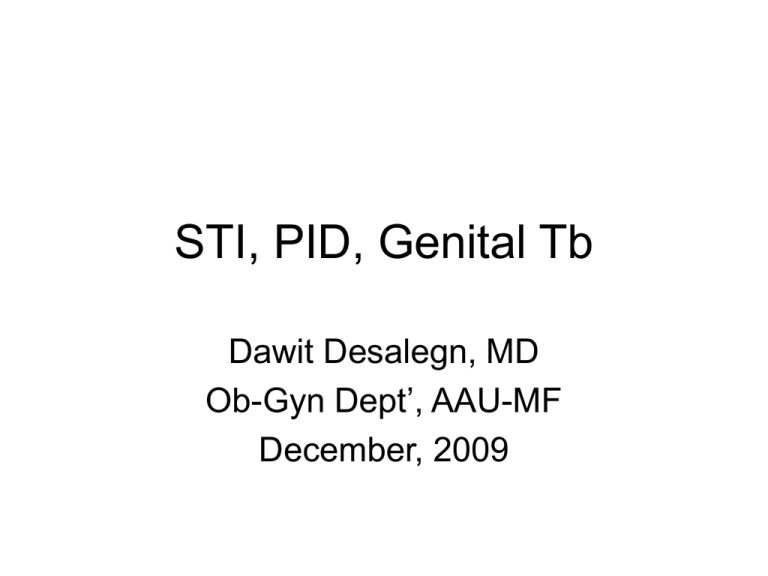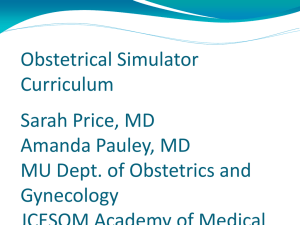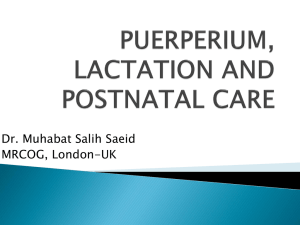
STI, PID, Genital Tb
Dawit Desalegn, MD
Ob-Gyn Dept’, AAU-MF
December, 2009
Sexually Transmitted Diseases
•
1.
2.
3.
4.
5.
The term denote disorders spread
principally by intimate contact:Sexual intercourse,
Close body contact, kissing, and anal
intercourse.
Transplacental spread,
Passage through the birth canal, and
Lactation during the neonatal period
Terminology
• WHO recommends that the term STD be
replaced by the term STI.
• STI has been adopted since 1999 as it
better incorporates asymptomatic
infections.
• Has also been adopted by a wide range of
scientific societies & publications.
Introduction
• the most common infectious diseases in the
most parts of the world
• five key points about all STDs today:
1. STDs affect men and women of all
backgrounds and economic levels.
- They are most prevalent among
teenagers and young adults.
- Nearly two-thirds of all STDs occur in
people younger than 25 years of age.
continued
2. The incidence of STDs is rising
- Because in the last few decades, young people have become
sexually active earlier yet are marrying later.
- In addition, divorce is more common.
- The net result is that sexually active people today are more likely
to have multiple sex partners during their lives and are
potentially at risk for developing STDs.
continued
3 Most of the time, STDs cause no symptoms,
particularly in women.
- When and if symptoms develop, they may be confused
with those of other diseases not transmitted through
sexual contact.
- Even when an STD causes no symptoms, however, a
person who is infected may be able to pass the
disease on to a sex partner.
- recommend periodic testing or screening for people
who have more than one sex partner.
continued
4,
STDs tend to be more severe and more frequent for
women than for men,
- because the frequency of asymptomatic infection many women do not seek care until serious problems
have developed.
- Some STDs can spread to cause PID, which in turn
infertility & ectopic (tubal) pregnancy.
- may be associated with cervical cancer; HPV
- causes genital warts
- other genital cancers.
continued
5. STDs can be passed from a mother to her baby
before, during, or immediately after birth;
- When diagnosed and treated early, many STDs can be
treated effectively.
- Some infections have become resistant to the drugs
used to treat them and now require newer types of
antibiotics.
STD; microorganisms
• Long list
1. Transmitted by sexual route
(conventional STI)
2. Transmission described but less defined
evidence
Cont’d; Organisms transmitted sexually
•
1.
2.
3.
4.
5.
6.
Bacteria
N. gonorrhea
C. trachomitis
T. pallidum
H. ducreyi
C. granulomatis
U. urealyticum
•
1.
2.
3.
4.
5.
Viral
HIV
HSV
HBV
HPV
Molluscom
contagiosum virus
• Others
1. T. vaginalis
STDs; described but less defined for sexual transmission
• Bacteria
1. M.hominis
2. G. vaginalis
•
1.
2.
3.
4.
•
1.
2.
Viral
CMV
HCV
HSV type 8
EBV
Others
C. albicans
S. scabiei
Sexually transmissible
1.
2.
3.
4.
5.
6.
Gonococci and Chlamydia infections
Syphilis
Genital herpes
Papilloma virus infection
LGV, Chancroid and GI
Miscellaneous causes
Approaches to STD Dx & Rx
Three approaches
1. Laboratory based
2. Clinical without laboratory support
3. Syndromic Approach
Background
• Traditional approach to STD Dx and Rx
relies on laboratory diagnosis to determine
etiologic agents
Expensive
Involves delay in Dx and Rx
Depends on technician and lab accuracy
Often not available in resource poor settings
Requires quality control procedures
…Background
• Alternative approach – Clinical Dx
Presumptive Dx of one etiology based on
clinical findings
Often inaccurate and incomplete
• Similarities of Sn and Sx
• Misses Co-infection
• Atypical presentation - HIV
Definition
• Syndromic Management is a management approach
that uses clinical algorithms on an STD Syndrome, the
constellation of patient symptoms and clinical signs to
determine therapy.
• Algorithms are adapted to local STD prevalence
• Chooses antimicrobial agents to cover all the possible
pathogens responsible for the syndromes in the specific
geographic area.
Syndromic Management
History
In 1991 WHO developed and started
advocating the syndromic approach to
address the limitation of aetiological (lab)
& presumptive(clinical) Dx & Mx
…Syndromic Management
Based On
Recognition of relatively consistent and characteristic
combinations of easily elicited Sx and easily recognized
Sn (Syndromes) with which STD commonly presents
Knowledge of the most common etiologies of different
syndromes
Knowledge of antimicrobial susceptibility pattern
Knowledge of behavioral & demographic characteristics
of people with STD
…Syndromic Management
Components
1. Identification and Rx of the Syndrome
2. Education and counseling on
- Rx compliance
- Risk reduction including condom use
3. Partner notification
4. Provision of condoms
5. VCT for HIV
Advantages
• Expedited care
• Cost savings – less technically demanding
• Increased client satisfaction
• Treatment at first visit
Decreases further transmission
Decreases complication
Eliminates need for return visit
• Decrease incidence of HIV (by 42% in Tanzania)
…Advantages
• Uses flow charts in case Mx which
Standardizes Dx,Rx, referral and reporting
Improves surveillance
Improves programme Mx
• High sensitivity
• Gives emphasis to non-medical aspects of
STD care
Disadvantages
• Inevitable over treatment (multiple antimicrobials
for single infection)
• Does not address subclinical and asymptomatic
STI
• High sensitivity is at the cost of specificity
• Doesn’t address poor health care seeking
behavior for STD Sx
• Works well with some syndromes (GU,UD) but
not as well with others (VD)
…Disadv.
• Rx with multiple drug might be expensive and
• The recommended drugs may not be available
• But, cost effectiveness increases further when
Applied to high STD prevalence areas
Long term cost of STD is considered
Increased HIV transmission and continued
STD transmission is considered
Major STD Clinical Syndromes
•
•
•
•
•
•
•
Genital ulcer
Urethral discharge
Abnormal vaginal discharge
Lower abdominal pain
Bubo inguinale
Scrotal swelling
Neonatal conjuctivitis
Genital Ulcer Disease (GUD)
•
1.
2.
3.
•
•
Algorithms for GUD try to identify presence of
Herpes,
Syphilis and/or
Chancroid
Frequency of causative agents differ in different
parts
Review – syndromic treatment without lab
support showed high cure rate
100% - Cote D’ivore
64% - Zambia
Herpes Simplex Virus
– DNA virus
• remain in latent form
• other members of the family includes VZ, CMV ,EBV
• there are different antigenic strains
• but are divided in two:• Type1 = oral
• Type2 = genital
– primary infection occurs in child hood
– latent infection resides in the sensory ganglion of trigeminal,
sacral & vagal
– 50 -100% of adults have serologic evidence of HSV1
– 20-80% type2
HSV Cont…
• transmission = only by direct contact
• clinical disease
• painful papule followed by vesicle ,ulceration
crusting & healing
• more sever in women
• Primary Vs Recurrent
• primary episode
–
–
–
–
more symptomatic
incubation range 2-14 days
there is fever & lymphadenities
viral shedding & healing prolonged
HSV Cont…
• recurrent episode
– frequently have prodromal period signaling active viral
replication,
– lesions are often localized
– shedding is shorter
– recurrences is not usually from re infection but are
reaction of latent viruses
• Diagnosis
= mainly clinical
– Tissue culture
• best method but lengthy and costly
– ELISA testing 70%
– Direct immunofluoresent staining 75%
sensitive
= both the negative culture and smear
don't exclude infection
Syphilis
• organism characteristics & microbiology
– By treponema pallidum
– is tightly coiled a spirochete that can not be grown
– can invade intact mucous membrane or area of abraded skin .
• incidence and epidemiology
– the incidence is rising
– only 30% of patients exposed acquire the disease
– in those infected patients not taking medication 60% do develop
immune defense sufficient to control the infection
– the remaining will go to late and tertiary syphilis
• Clinical diseases
1. EARLY SYPHILIS
A = primary syphilis,
•
•
•
•
painless chancre is the whole mark
it occurs at the site of inoculation
there is regional lymphadenopathy
incubation period 10-90 days
B = 20 syphilis
- mucocutaneous skin lesion 6-8weeks after the
original inoculation
- alopacia, hepatitis & nephrotic syndrome
continued
2. Latent syphilis
– characterized by serologic evidences but no clinical signs
&symptoms
– most patients are not infectious about 25% could have recent
skin lesion
– arbitrary division of this stage but has no clinical significance with
regard to treatment
– early latency (< 4 years from initial infection )
– late latency (>4 years )
continued
3. LATE SYPHILIS
• 5-30 years after initial infection
– there are three divisions
1. benign disease(gummas) - lesion occur in vital organs
– can be life threatening if they compromise the organ
2. cardiovascular disease - involvement of the heart and the aorta are
frequent dysfunction may cause serious problem
3. neurological diseases - three clinical syndromes of neurological
involvement
– asymptomatic disease no neurological manifestations but abnormal
CSF
– meningovascular disease the commonest manifestation is paresis
,(tabis dorsalis)
– parenchymatous disease dementia the commonest manifestation
• Diagnosis
A. Non treponemal specific test:• RPR (rapid plasma reagin) test,
• standard VDRL slide test,
B. Treponemal specific test;
• FTA-ABS; fluorescent treponemal antibody absorbed (used
commonly for adults ),
• MHA_TP micro haemagglutination assay( for neonates)
C. Dark field microscopy
• the higher the titer the higher the inflammatory reaction
• false +ve tests in chronic illnesses
– e.g. leprosy
- auto immune diseases( lupus)
– pregnancy
- drug addiction
Chancroid
• Haemophilus ducreyi :- a gram negative
bacteria
• is a painful soft chancre ragged with raised
borders
• kissing ulcers do occur
• unilateral lymphadenopathy that may
suppurate
• incubation period is 2-5 days
• the organism is fastidious
…GUD
Genital ulcers
Patient complains of genital sore or ulcer
Examine
Ulcer present?
Yes
-Treat for syphilis and
chancroid
-Educate
-Counsel if needed
-Promote/provide condoms
-Partner management
-Advise to return in 7 days
No
Vesicular/recurrent
lesion(s) present?
Yes
-Management of
herpes
-Educate
-Counsel if needed
-Promote/provide
condoms
-Educate
No -Counsel if
needed
-Promote/provide
condoms
…GUD
• Syphilis
Recommended regimen
Benzantine Penicillin 2.4miu im singledose
Alternative regimen
Procaine Penicillin 1.2miu im for ten days
Penicillin allergy– TTC 500mg po qid/15d
or doxycycline 100mg po bid/15d
…GUD
• Chancroid
Recommended regimen
Erythromycin 500mg po qid/7days
Alternative regimen
Ciprofloxacin 500mg single dose or
Ceftriaxone 250mg im single dose or
Spectinomycin 2gm im single dose
…GUD
• Herpes – to modify course of symptoms
• 1st episode – acyclovir 200mg 5x per day /7
days(doesn’t appear to influence natural Hx of
recurrent disease)
• Recurrence – acyclovir 200mg tid continuously
for frequently recurring outbreaks(>6 per year)
Inguinal Bubo
• Inguinal adenopathy
• LGV (L1,L2,L3),
• Chancroid,
• G I (donovanosis) is
– Klebsiella granulomatis, formerly known as
Calymmatobacterium granulomatis
• Common in the tropics as a cause of genital ulcer
• Men affected more than females
• Prostitution is reservoir
• Painful adenopathy
Inguinal Bubo, cont’d
• Rare systemic symptoms except LGV
• Common predisposing factor for the
spread of HIV
• Complications:
–
–
–
–
–
Abscess formation
PID
Lymphatic obstruction
Stenosis
Infertility
Differential Diagnosis
• Infection in the lower limbs and
perineum
• Malignancy
• Herpes genitalis
• Syphilis
Inguinal Bubo
Enlarged and/or painful inguinal lymph nodes?
Examine
Ulcer(s) present?
Yes
No
-Treat for lymphogranuloma
venereum
-Educate
-Counsel if needed
-Promote/provide condoms
-Partner management
-Advise to return in 7 days
Use genital ulcers flow chart
…Inguinal Bubo
• Recommended regimen (LGV)
Doxycycline 100mg po bid/14 days or
TTC 500mg po qid/14 days
• Alternative regimen
Erythromycin 500mg po qid/14 days or
Sulfadiazine 1gm qid/ 14 days
• Aspirate fluctuant lymph nodes through normal
skin
• Incision and drainage or excision of nodes is
contraindicated
Vaginal Discharge (VD)
• Most difficult syndrome to diagnose
• Either vaginitis or cervicitis
• Cervicitis- N.gonorrhea
- C.trachomatis
• Vaginitis - Trichomonas vaginalis
- Candida albicans
- Bacterial vaginosis
• Effective management of cervicitis is more important from
patient point of view b/c of serious sequele
…VD
• VD is not an adequate indicator of any particular
STD making it a poor algorithm entry point
• Use of risk assessment has shown to improve
performance of syndromic management
algorithms
• The probability of correct Rx of STI relative to
probability of overtreatment is increased
…VD
• Risk scores use variables that are common risk
predictors for STD
Young age less than 21
Multiple partners
Partner has urethral discharge
New partner in the past three months
Patient is single
• Need adaptation to local,social and behavioral
conditions and should be periodically updated
…VD
Vaginal Discharge
Patient complains of vaginal discharge
(vaginal itching)
partner symptomatic or
specific risk factors positive?
No
Yes
-Treat for cervical and vaginal infections
-Educate
-Counsel if needed
-Promote/provide condoms
-Partner management
-Return if necessary
-Treat for vaginal infection
-Educate
-Counsel if needed
-Promote/provide condoms
…VD
Vaginal Discharge (with speculum)
Patient complains of vaginal discharge
(vaginal itching)
partner symptomatic or specific
risk factors positive?
No
Yes
Treat for cervical infection plus vaginal infection
according to speculum examination findings
Mucopus from
Cervix?
Profuse
VD?
Curd-like
VD?
& bacterial vagionosis
-Educate
-Counsel if needed
-Promote/provide
condoms
-Partner Mx
-Return if necessary
No
discharge?
Cervical
motion
tenderness
present?
-Educate
-Counsel if
candida
needed
-Educate
-promote/provUse flow-Counsel if ide condoms
chart for
needed
lower
-Promote/provide
abdominal
condoms
pain
-Return if necessary
-Treat for cervical & -Treat for trichomonas -Treat for
vaginal infections
-Educate
-Counsel if needed
-Promote/provide
condoms
-Partner Mx
-Return if necessary
Speculum and bimanual
vaginal examinations
…VD
Treatment
Cervicitis (Gonorrhea & Chlamydia)
Recommended regimen
Ciprofloxacin 500mg po single dose or
Ceftriaxone 250mg im single dose or
Cefixime 400mg po single dose or
Spectinomycin 2gm im single dose
Plus
Doxycycline 100mg po bid/7 days or
TTC 500mg po qid / 7 days or
Erythromycin (pregnant)
…VD
Vaginitis
Recommended regimen
metronidazole 2gm PO single dose or
metronidazole 500mg PO bid/7 days
plus
Nystatin 100,000 IU intra vaginally once/14 d, or
Clotrimazole 200mg once daily/3 days, or
Clotrimazole 500mg single dose
Lower Abdominal Pain (LAP)
Patient complains of lower abdominal pain
Take history and examine
(abdominal and vaginal)
Missed/overdue
period or
Recent delivery
/abortion or
Rebound
tenderness or
Guarding or
Vaginal bleeding
Yes
Refer
No
No
Temp 38°C or Pain during
examination (on moving cervix)
or Vaginal discharge
Yes
-Treat for PID
-Educate
-Counsel if needed
-Promote/provide condoms
-Partner management
Follow up after 3 days or
sooner if pain persists
Continue Rx
Yes
Improved?
No
Refer
Follow
up if
pain
persists
PID
• PID refers to acute infection of the upper
genital tract (above the internal cervical os)
• community-acquired Vs Iatrogenic
• USA - annually 2.5 million outpatient visits,
• 200,000 hospitalizations, and
• 100,000 surgical procedures
• incurs an annual total expense of more than
$5 billion
• Acute PID= attributed to an ascending
spread of microorganisms from the vagina
and endocervix.
• Acute PID Vs Acute salpingitis
– are often used interchangeably,
– but PID is not limited to tubal infection only.
• A more descriptive term = (UGTI).
– Severity & Extent of disease
• This is differentiated from (LGTI) because
response to treatment appears to be
different in these two entities.
•
•
•
•
•
Etiology
Neisseria gonorrhoeae and Chlamydia
trachomatis serovars D-K
common cause of PID = 1/3rd each;
However, most = polymicrobial infection
caused by ascending infection
15% of infections occur after procedures
that break the cervical mucous barrier
C. trachomatis etiologic role is very
different from N. gonorrhea
•
•
•
•
•
N. Gonnorrhea
Gram-negative IC
diplococcus
rapid cycle 20 to 40
minutes to divide
rapid and intense
inflammatory
response
Less complication
Early Rx
•
•
•
•
•
•
C.Trachomatis
is a slow-growing
intracellular organism.
lack of mitochondria
growth cycle 48 to 72
hours
does not induce a
rapid or violent
inflammatory
response
destruction by rupture
Delayed Rx
Initial PID →
• tissue damage provides fertile ground for
the growth of secondarily infecting aerobic
and anaerobic bacteria.
• This necrotic tissue is an excellent growth
medium, and
• the epithelial damage enhances the
breakdown of the surface defense
mechanisms
•
•
•
•
•
•
Classification:Post STI / menustral
Post abortal
Post Partum
Post Instrumentation
IUD – Related
Secondary PID
• Risk Factors
1. STI
2. Age
– Adolescent 1:8 Vs 1:80 for a sexually active >24, b/c
columnar epithelium
3. Contraceptives
–
–
–
–
IUDs = threefold to fivefold
Barriers = ↓ 60%
OCP = ↓ risk, good Px fertility
previous tubal ligation = 1/450;
4. Instrumentation ex. 1/200 induced abortion
5. Previous acute PID = 25 %,
- partner treatment
• Criteria for the Diagnosis:Major Criteria:• Cervical motion tenderness or
• Lower abdominal / uterine tenderness or
• Adnexal tenderness
Other minor criteria:• Oral temperature >101°F (>38.3°C)
• Abnormal cervical or vaginal mucopurulent discharge
• Presence of abundant numbers of WBC on saline
microscopy of vaginal secretions
• Elevated ESR
• Elevated C-reactive protein
• Laboratory documentation of cervical infection with N.
gonorrhoeae or C. trachomatis
The most specific criteria:• Endometrial biopsy with histopathologic
evidence of endometritis
• Transvaginal sonography or MRI
• Laparoscopic abnormalities consistent with PID
• Doppler studies suggesting pelvic infection
(e.g., tubal hyperemia)
•
•
•
•
•
DDX:Acute appendicitis,
Endometriosis,
Torsion or rupture of an adnexal mass,
Ectopic pregnancy, and
LGTI
• Complication:Early
• Sepsis → MOF → Death( ruptured TOA =
10 %)
• Surgical morbidity (TOA)
Late
• Infertility = 20%
• Ectopic Pregnancy = 6-10X higher; 12 %
• Chronic pelvic Pain = 20%
• Chronic PID
• Psychological consequences
Fitz-Hugh-Curtis syndrome,
• Perihepatic inflammation and adhesions,
• develop in 1% to 10% of acute PID.
• RUQ- pain & tenderness, pleuritic pain,
• DDX = acute cholecystitis or pneumonia.
• Develop from vascular or transperitoneal
dissemination of either N. gonorrhoeae or C.
trachomatis to produce the perihepatic
inflammation.
Treatment
• based on the consensus that PID is
polymicrobial in cause.
• Empirical antibiotic protocols should cover
a wide range of bacteria
• Oral therapy can be considered for women
with mild to moderately severe acute PID
Grading of severity
Clinical system
Grade I:
Disease limited to the adnexae
Grade II: PID with an inflammatory mass
Grade III: Ruptured tubo-ovarian abscess
Operative system
Mild:
Erythema and edema of the adnexae
Moderate: Purulent exudate from fallopian tubes
Severe:
Pyosalpinx, inflamatory complex, TOA
CDC-Recommended Treatment Regimens for Oral
Therapy
• Regimen A
- Levofloxacin 500 mg orally once daily for 14 days
OR
- Ofloxacin 400 mg orally once daily for 14 days
WITH OR WITHOUT
- Metronidazole 500 mg orally twice a day for 14 days
• Regimen B
- Ceftriaxone 250 mg IM in a single dose
PLUS
- Doxycycline 100 mg orally twice a day for 14 days
WITH OR WITHOUT
- Metronidazole 500 mg orally twice a day for 14 days
Criteria for Hospitalization
• Surgical emergencies (such as appendicitis)
cannot be excluded.
• Pregnant.
• No response clinically to oral therapy.
• Unable to follow or tolerate oral regimen.
• Has severe illness, nausea and vomiting, or high
fever.
• The patient has a tuboovarian abscess.
• Adolescents
• HIV / Aids
CDC-Recommended Parenteral Treatment
Regimen A
- Cefotetan 2 g IV every 12 hours
OR
- Cefoxitin 2 g IV every 6 hours
PLUS
- Doxycycline 100 mg orally or IV every 12 hours
Regimen B
- Clindamycin 900 mg IV every 8 hours
PLUS
- Gentamicin
• D/C IV 24 hours after a patient improves clinically;
• Continue oral therapy
– doxycycline 100 mg orally twice a day or
– Clindamycin 450 mg orally four times a day
• complete a total of 14 days of therapy
• Male sex partners of women with PID
should be examined and treated
• Education for the prevention of reinfection,
• Proper contraception
Surgical Mx
• Laparascopy
• Laparatomy
• Colpotomy
• Percutaneous drainage
Pelivic Tuberculosis
• it is a frequent cause of chronic PID and
infertility in developing world
• produced primarily by either: – Mycobacterium tuberculosis or
– Mycobacterium bovis
• The fallopian tubes = predominant site
• spread to the endometrium → ovaries.
Female reproductive tract are usually
infected by:1. Hematogenous miliary spread from a primary
pulmonary lesion,
2. Hematogenous spread from a secondary
miliary site
3. Lymphatic spread from a primary pulmonary
site to intestinal lymph nodes and then to the
pelvis,
4. Direct extension from adjacent abdominal
organs
5. A venereal transmission
Pathology of Pelvic Tuberculosis
• Both fallopian tubes are involved
• Tuberculous endometritis = 50%.
• Tuberculosis of cervix is present in 5%
• The vagina and vulva = 2%
• Ovaries = only surface involvment.
• The mucosa of tubes may not be involved
• 38% of women with genital tuberculosis had
previously had tuberculosis in other organs,
usually the lungs
Clinical Features
• most often = 20 and 40 years
• Chronic pelvic pain,
• Inflammatory Pelvic Mass
• General malaise, low grade fever
• Menstrual irregularity (50%), and infertility
• Amenorrhea or oligomenorrhea = 27%
• Failure of fever to subside with high doses of
broad-spectrum antibiotic
• 10-20 % of pts with pulmonary Tb have pelvic Tb
Diagnosis
• Mainly clinical
• Biopsy
– dilatation and curettage or endometrial biopsy
– From cervical ulcer
•
•
•
•
•
HSG
Culture – menstrual blood, luteal phase
Laparatomy / Laparoscopy
Acid-fast stains of tissue
Other studies ex. CXR, Culture etc…
• Treatment
A. Medical
• Daily INH, RIF, and PZA for 8 wk, followed by 16
wk of INH and RIF daily or 2 - 3 times/wk
• Other DOT regimens ex.:-
• Daily INH, RIF, PZA, and SM or EMB for 2 wk,
then administer the same drugs 2 times/wk for 6
wk (by DOT).
– Next, administer INH and RIF 2 times/wk for 16 wk
(by DOT).
•
B. Surgical
1. Persistence or enlargement of an adnexal
mass after 4 to 6 months of antituberculous
antibiotic therapy.
2. Persistence of pelvic pain or recurrence of
pelvic pain while on medical therapy
3. Primary unresponsiveness of the tuberculous
infection to antibiotic therapy
4. Difficulty in obtaining patient cooperation for
continued long-term therapy
Thank You all
Merry X-Mas







